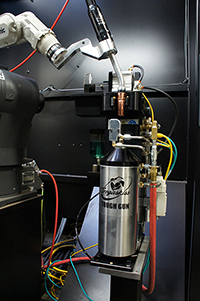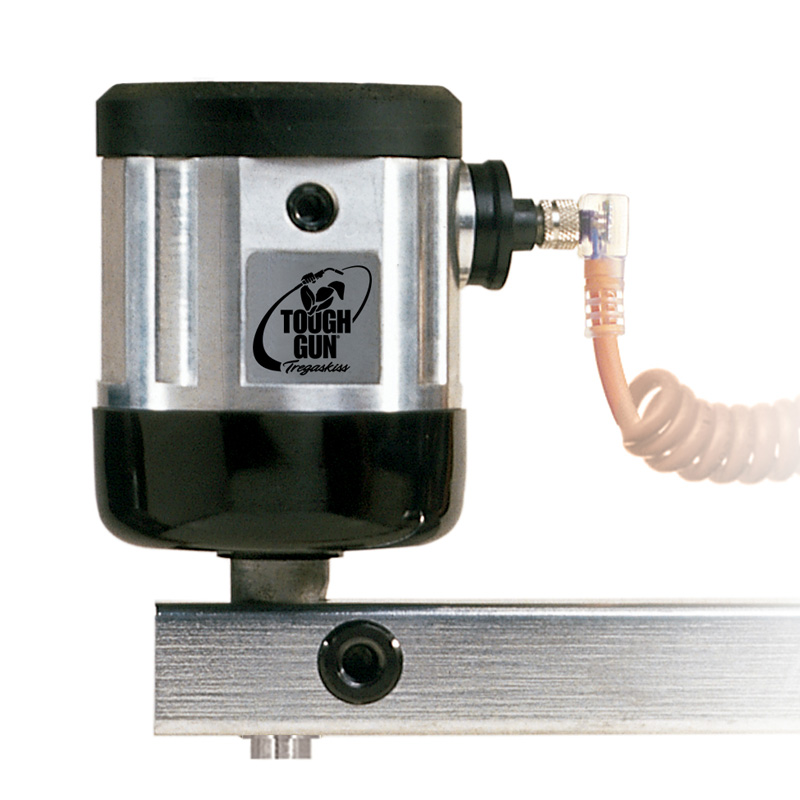Don’t Be Marginalized
Learn How Peripherals Can Maximize Your Robotic Welding Performance

Robotic welding systems introduce speed, accuracy and repeatability into the fabrication process. The repeatability of these systems can increase productivity and reduce welding production costs, thereby maximizing the return on the investment in automation. When compared to semi-automatic welding operations, a robot has the ability to perform the same or more tasks, with extreme precision and a lower labor cost per part.
Still, achieving these results isn’t subject to chance. It’s the result of careful equipment purchases, software programming and operator training. In many cases, it can also be the result of complementary equipment called peripherals.
Peripherals are any equipment integrated into the robotic welding process with the objective of maximizing its effectiveness and protecting the overall equipment investment. In short, these devices (in most cases) can add significantly to the ROI a company achieves with its welding robot. The key to successful peripheral selection and usage, like that of any other equipment, is simply a matter of education.
Get a Grip
All robotic welding systems require some form of collision detection in order to reduce the damage to both the robot and the welding system in the event of an impact. Impacts occur for several reasons. These include a robotic gun colliding with an incorrectly positioned work piece or tooling that has been left out of position, or striking an item that has inadvertently been left in the weld cell.
Depending on the type of collision detection utilized by the particular robot manufacturer, it will require either a shock sensor or safety clutch as protection. In cases where collision detection is integral to the robot, a clutch is not required.
The sensitivity of a clutch or shock sensor can be calibrated to accommodate the robotic welding gun’s mass and moment of inertia. The function of a clutch is both mechanical and electrical. The clutch first recognizes the physical impact of the torch on a solid surface, which sends an electrical signal back to the robot controller, causing the system to stop. This action prevents damage to the robot and the robotic gun. It also alerts the welding operator overseeing the operation that there is an incorrect variable in the weld cell.
Some robotic systems are capable of monitoring current rates and/or torque via robot collision detection software that stops the robot in the event of an impact. In this situation, a solid arm mount would be used in lieu of a clutch on conventional style robots. As its name implies, a solid arm mount is just that: solid. It does not provide electrical feedback during an impact, but rather relies on the software to stop the robot during an impact.
Clutches and solid arm mounts are also quite robust and require little to no maintenance to keep them operating to their fullest. However, should a company feel that maintenance or repairs are necessary for one of these peripherals, maintenance personnel should contact their welding distributor, integrator or robotic equipment manufacturer for advice.
Making the Cut
For companies whose robotic welding applications require consistent welding wire stick-out (the distance the wire extends from the end of the contact tip) when the arc initiates, a wire cutter is recommended. Note, consistent welding wire stick-out is not required for all applications.
Again, as its name implies, a wire cutter cuts the welding wire to a specified length or stick-out and/or it also removes any balling at the end of the wire. In doing so, this peripheral helps provide smooth arc starts. It also helps attain reliable, repeatable welds, as many companies who own automated systems program the robot to seam track, or find the joint, with touch sensing. This touch sensing depends on the robotic MIG gun having a consistent length of wire with which to locate the correct spot and begin welding.
Most wire cutters are designed to cut a range of different types of welding wire, including stainless steel, flux-cored and metal-cored, usually up to 1/16-inch diameter. They can often be mounted on a nozzle station (to be discussed later) or remotely located to be used as needed.
Inspected and Ready to Weld
Another key peripheral is a neck (or gooseneck) inspection fixture. A neck inspection fixture tests the tolerance of a robotic MIG gun’s neck to the tool center point so it can be readjusted after an impact or after bending due to routine welding. Most inspection fixtures will accommodate standard necks for that particular brand of robotic gun. They are designed with a precision-tooled steel base to withstand the harsh robotic welding environment and also to guarantee accuracy after long-term use.
The advantage of adding a neck inspection fixture to a robotic weld cell is two-fold. One, it ensures the neck meets the specifications to which the robotic welding system has been programmed. Once the tolerance has been determined, a trained welding operator simply adjusts the neck accordingly. This adjustment helps prevent costly rework due to missing weld joints. Accurate neck adjustments also prevent the downtime necessary to reprogram the robot to meet the welding specifications with the existing bent neck.

of an impact by signaling to the robot
to stop welding
Secondly, a neck inspection fixture can save companies time, money and confusion when exchanging necks from one robotic MIG gun to another. This is especially advantageous for companies that maintain a large number of welding robots. Welding operators can simply remove a bent neck and change it with a spare that has already been inspected and adjusted, and put the robot back in service immediately. The damaged neck can then be set aside for inspection while the robot is still online. This again lowers downtime and also helps companies save money for extra parts.
Cleaned, Sprayed and Spatter-Free
One of the most important peripherals a company should consider for its robotic welding system is a nozzle cleaning station, also called a reamer. This peripheral can be used by itself or in conjunction with a sprayer that applies anti-spatter compound.
A nozzle cleaning station cleans the robotic gun nozzle of spatter and/or clears away debris in the diffuser that accumulates during the welding process. If a sprayer has been mounted on the nozzle cleaning station, it will apply a water- or oil-based anti-spatter compound to protect the nozzle, diffuser and work piece from spatter after it has been cleaned.
Again, there are several benefits a nozzle cleaning station can have on the robotic welding process. First, by minimizing the accumulation of spatter and debris in the nozzle, it helps lengthen the life of the robotic gun consumables (nozzle, contact tip and diffuser), and of the robotic gun itself. This longer equipment life translates into less downtime and labor for component changeover and also less cost for equipment—both factors contribute positively to a company’s ROI of its robotic welding system. A clean nozzle also helps provide better weld quality and reduce problems that could lead to rework.
To achieve all of these benefits, it’s important to consider two factors: one, the location of the nozzle cleaning station, and two, the timing of its use. Ideally, the nozzle cleaning station should be placed in close proximity to the welding robot so that it is easily accessible when cleaning is necessary. As well, the nozzle cleaning process should be programmed so that the function occurs in-between cycles—during part loading or tooling transfer. In this case, the cleaning time would not be added to the overall cycle time per part, as a typical nozzle cleaning station needs only a matter of three or four seconds to complete the job.
If a company attaches a sprayer to its nozzle cleaning station, it should be certain to use only the minimum amount of anti-spatter compound required for the application. Excessive anti-spatter usage can lead to unnecessary costs and the compound may build up on the nozzle, the welding robot and the parts being welded. In the long term, a high spray volume could cause additional problems that are just as bad as spatter build-up itself.
Finally, implementing a preventative maintenance plan for a nozzle cleaning station is imperative to gaining long-lasting results from the equipment. And it’s easy. Simply clean off the peripheral, wiping it free of dirt, debris and/or spatter, on a weekly basis to prevent malfunctions, and in turn, quality issues in the robotic weld cell.
No Peripheral Decision
The decision for a company, large or small, to invest in robotic welding equipment is significant. It requires time, knowledge and a trusted relationship with a robotic welding equipment manufacturer and/or integrator to find the right system for the application. The same holds true for peripherals. And although these devices do add to the initial cost of automating, they can lead to measurable cost savings and profits in the long term. Remember, the goal in robotic welding is repeatability and increased productivity, any additional equipment that can help achieve that result is worth the consideration.